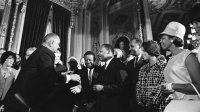Resources for Martin Luther King Jr. Day
A collection of lesson plans, curricula, and multimedia resources for teaching the life and legacy of Dr. Martin Luther King Jr.
Since Martin Luther King Jr. Day was signed into law in 1983, the holiday has provided an opportunity for Americans to honor and learn from the iconic figure. Yet teaching about King’s cultural legacy shouldn’t be limited to January and February. That legacy should be celebrated and analyzed in classrooms throughout the year. And at this moment in American history, King’s philosophy of nonviolence can help bring balance to classroom discussions.
The key, though, is ensuring that King’s ideas aren’t oversimplified, wrote Melinda D. Anderson in The Atlantic. Students should be encouraged to examine King through a broader lens, and to research his important ideas in areas like voting rights, housing and economic inequity, nonviolent activism, and social justice. The Dos and Don’ts of Celebrating MLK Day, from Learning for Justice, offers some wonderful ideas to start.
To help educators inspire fruitful classroom discussions, we’ve compiled a list of lesson plans, curricula, and multimedia resources to discover King’s philosophy and teachings through new eyes.
- Liberation Curriculum: Stanford University’s Martin Luther King, Jr. Research and Education Institute is a wonderful source of learning materials. This curriculum includes lessons geared toward middle and high school with some offerings for K–5, and provides a framework for unique investigations into King’s legacy. Plus, check out the classroom resources section for additional materials.
- Literacy and Civil Rights Lesson Plan: A part of the Gilder Lehrman Institute of American History’s Teaching Literacy Through History series, this three-part lesson encourages students to compare and contrast the distinctive philosophies of King and Malcolm X. The Common Core–aligned lesson is designed for students in grades 7–12. Note: This resource is free for K–12 teachers and students, but you must register for a free account to access it.
- Learning About Nonviolent Philosophy: Facing History’s three-part examination of nonviolence introduces students to the goals and rationales of one of King’s key philosophies and to the six steps of nonviolent social change that activists practiced and the tactics they used.
- Examining Nonviolence in Context: EDSITEment, from the National Endowment for the Humanities, offers a multi-part lesson plan for discovering the influences and impact of King’s nonviolent social activism. The site also offers lessons for younger students, including Let Freedom Ring: The Life & Legacy of Martin Luther King, Jr. (grades 3–5) and Dr. King’s Dream (grades K–2).
- Racial and Social Justice Curriculum: Produced by the Alonzo Crim Center for Urban Education, this curriculum has lessons for the elementary and middle grades, and offers students a chance to consider the civil rights movement’s past and present.
- Videos and Other Online Resources: The PBS Black Culture Connection has put together a set of videos about King and his legacy, including a student’s moving recital of the “I Have a Dream” speech. And there’s a quiz: Who said it—Martin Luther or Martin Luther King Jr.?
